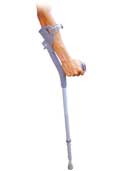Walking Crutches: There are 3 basic types of walking crutches and they are used to reduce weight bearing on one or both legs, or to give additional support where balance is impaired and strength is inadequate.
- Arm Crutches
- Elbow Crutches
- Forearm Crutches
1. Arm Crutches:
 |
|
Measurement of length It is usually carried out with patient in lying.
With shoes off measure from apex of the axilla to the lower margin of the medial malleolus.
With shoes on 5cm below the apex of the axilla to a point 20 cm lateral to the heel of the shoe. This tends to be less accurate than the first method.
The measurement from the axillary pad to the hand grip should be taken with the elbow slightly flexed (approximately 15 degree) from a point 5 cm below the apex of the axilla to the styloid process.
2. Elbow Crutches:
 |
|
Measurement of length It is usually carried out with patient in lying with shoes on. The Elbow Crutch slightly flexed (approximately 15 degree) and the measurement is taken from the ulnar styloid to a point 20 cm lateral to the heal of the shoe. Once the patient is standing with support, the length must be checked.
3. Forearm Crutches:
 |
|
Measurement of length If the patient can stand, it is better to assess the required length in this position from elbow to the floor. Measurement can be carried out with the patient lying with shoes on, and is taken from the point of flexed elbow to 20 cm lateral to the heel.
Preparation for crutch walking:
Arms: The power of the extensors and adductors of the shoulder and the extensors of the elbow must be assessed and if necessary strengthened before the patient starts walking. The hand grip must also be tested to see that the patient has sufficient power and mobility to grasp the hand piece.
Legs: Non weight bearing- The mobility and strength of the unaffected leg should be assessed, paying particular attention to hip abductors and extensors, the knee extensors and the plantar flexors of the ankle. These muscles must be sufficiently strong to take weight.
Partial weight bearing- The mobility and strength of both legs should be assessed and muscles strengthened where necessary.
Balance: Sitting and standing balance must be tested and trained if necessary.
Preparation for crutch walking:
Arms: The power of the extensors and adductors of the shoulder and the extensors of the elbow must be assessed and if necessary strengthened before the patient starts walking. The hand grip must also be tested to see that the patient has sufficient power and mobility to grasp the hand piece.
Legs: Non weight bearing- The mobility and strength of the unaffected leg should be assessed, paying particular attention to hip abductors and extensors, the knee extensors and the plantar flexors of the ankle. These muscles must be sufficiently strong to take weight.
Partial weight bearing- The mobility and strength of both legs should be assessed and muscles strengthened where necessary.
Balance: Sitting and standing balance must be tested and trained if necessary.










No comments:
Post a Comment